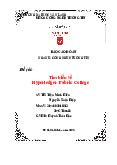























































Preview text:
The GitLab 2022 Global DevSecOps Survey 2 Whatʼs inside? Introduction 03 Security 19 Security top findings Overview 04 Security and DevSecOps
2022 DevSecOps Survey top findings Roles are changing The starting point Shifting left Software development today Who’s in charge?
The root causes of release delays A look at testing The increasing role of AI/ML Looking to the future
Of toolchains and popular tools
The role of the DevOps platform Operations 23 Operations top findings Developers 14 Operations Develoment top findings Still so many tools Devs and DevOps Working with development Developer daily life Looking to the future Security Looking to the future
Keeping the DevOps momentum 27 3 Introduction
For six years now we’ve been asking DevOps teams to share
their stories, successes, solutions, and struggles. In May 2022,
31% of teams are using AI/ML for code review, 16 points
5,001 people offered us a snapshot of “their DevOps,” and this higher than last year.
time it was set against a backdrop of sweeping socio-economic challenges.
60% of developers are releasing code faster than before.
With so many forces out of their control, it’s clear DevOps teams
We also heard about the challenges, including pandemic-based
focused on what could be accomplished: from deployment
culture changes, hiring and retention struggles, and the level of
velocity to automation, as well as release speed and adoption of
effort required to integrate complex new technologies like artificial
new technologies, the momentum was obvious. intelligence.
47% of teams have full test automation, nearly double But if there was one overarching concern, it was the very real threat the number in 2021.
security breaches represent. While security continues to “shift left”
70% of teams release code continuously, once a day, in many teams, it also is, perhaps for the first time, a driving force
or every few days, up 11% from last year.
for many decision makers when it comes to choosing a DevOps
platform or other technologies. The threat of security breaches is
Nearly three-quarters of DevOps teams are using a DevOps
also top of mind for many DevOps teams.
platform or plan to this year.
As always, a reminder this is our survey so it’s no surprise some
DevOps roles continue to shift: Developers are taking on ops
participants use our products. Also, roughly 60% of respondents
jobs, ops is cloud or platform-engineering focused, and security
have been “doing” DevOps for at least three years, so their
pros are “hands on” inside dev teams.
experiences may feel aspirational for newer, less seasoned teams. Let’s get started. 4 Overview
2022 DevSecOps Survey top findings
How does DevOps look today? Too many tools
Expect to see DevOps platforms, DevSecOps, CI/CD and test
69% of survey takers want to consolidate their (sometimes
automation at work in today’s DevOps teams.
sprawling) toolchains because of challenges with
monitoring, development delays, and unhappy devs.
Test automation is (nearly) here
And so is AI/ML for testing, code review, and more. Future planning
Security is the number one investment area for 2022, followed
DevOps works, across the board closely by cloud computing.
DevOps = better code quality, developer productivity, and operational efficiency. Security at center stage
Getting security right is the number one challenge for DevOps
teams and tools that help—like a DevOps platform—are in use and in demand.
Deploy, deploy, and deploy
70%of teams deploy multiple times a day, daily, or every few days, up 11% from 2021. 5 The starting point
In May 2022, 5,001 respondents completed our survey. Here’s a closer look at who they are: Gender Industry 45% 3% 26% Female
Computer Hardware / Services / Banking / Financial Services 72% Male Software / SaaS 2%
1% Non-binary/third gender 11% Biotech/pharm 1% Prefer not to say Automotive 2%
0% Prefer to self describe 5% Consumer products mfg Industrial manufacturing 2% 5% Insurance Telecommunications 2% Age 4% Healthcare 56% Retail 2% 4% Government 18-34 Business Services / Consulting 1% 36% 3% Aerospace & defense Energy & utilities 35-44 1% 3% Other 7% Media & Entertainment 45-54 3% Education 2% 55+ 6 Role Decision maker r status 15% 4% 54%
Software Developer / Software Engineer Software Architect Primary decision maker 9% 3% 37% Site Reliability Engineer
Development/Engineering Leadership
Not the primary decision maker but on the team that makes the decisions 8% 3% Operations Leadership DevOps Leadership 8% Provide decision making input 8% 3%
Technology Executive - CIO / CTO/VP
Systems Engineer / Network Engineer 2% Not decision makers 6% 2% Project Manager Release Manager 5% 2% Operations engineer App security engineer 4% 2% DevOps Engineer Quality Assurance 4% 2% Network security specialist Database engineer 4% 1% Security engineer
Technical writer/in charge of documentation 4% 1% Security leadership Site availability engineer 4% 1% Product Manager Other 4% Systems Administrator 7 Region Number of Employees Scotland 4% <1% 22 24 and less people 13% 1% England 25-49 people Ireland 245 69 5% The Netherlands 1% 40 21% 50-99 people 29% 100-249 people Germany 11% Canada 1% 3% 73 137 250-499 people Austria <1% Korea 20 US 1% 2% 34 Japan 9% 75% 3761 1% Pakistan <1% 22 500-999 people France 75 88 2% Philippines 5% 110 1000-2499 3% India 161 5% 5000+ Australia 2% 82 New Other 1% Zealand 1% 30 32 8 Software development
Most Practiced Development Methodologies today
In 2022, a majority of respondents (47%) DevOps/DevSecOps 47%
told us DevOps or DevSecOps was their
methodology of choice, an 11% increase Agile/Scrum 34%
over 2021. But while that’s substantial
progress in DevOps usage, it’s clear Kanban 24%
respondents, who could “choose all
that apply” when it came to software
methodologies, are still using a mix-and- Waterfal 26%
match development approach at least some
of the time. The percentage of teams using Water/Scrum/Fall 28%
Waterfall was up an astonishing 16% this
year over last year, while “Water/Scrum/Fall” Lean 29%
practitioners saw a 23% jump from last year.
Dev and ops professionals do have clear
favorites, however: 53% of devs use
A full 40% of respondents told us their DevOps practices are between three
DevOps/DevSecOps (and 50% of ops do as
and four years old, very much a “sweet spot” where they’ve known success
well), while a solid 30% of both groups also
and are comfortable with the processes and routines. Just a slightly smaller use Water/Scrum/Fall.
group, 35%, said their teams have been doing DevOps between one and two
years, while just 5% have had DevOps implemented for less than a year. About
That’s a long way of saying that DevOps
one-fifth of survey takers have had DevOps on board for five or more years.
shops aren’t necessarily monoliths. 9
What do today’s DevOps implementations look like? A DevOps platform was the
most likely to be part of the process (44%), followed by DevSecOps (42%), CI/
CD and test automation at 34%, and observability/monitoring at 30%. Last year,
11.5% of survey takers used AI/ML; this year the percentage more than doubled to 24%.
For the third year in a row, respondents said devs are the most likely to benefit
from a DevOps practice (64%), followed by ops (63%), and security (53%).
The top three reasons to choose DevOps? Better code quality, developer
productivity and operational efficiency were called out by 37% of survey takers,
followed very closely by better security/more secure applications. Other clear
benefits from a DevOps practice included increased time to market, better
communication/collaboration, and happier developers/DevOps team members.
An impressive 70% of survey respondents said their teams deploy multiple times
a day, once a day, or once every few days, up 11% from 2021. All told 27% deploy
continuously (multiple times a day), while 14% deploy once a day, and 29% deploy every few days.
Not surprisingly, the vast majority of survey respondents participate in
open source projects – 64% in 2022, down slightly from last year. And
70% of those participants have contributed to GitLab, up an impressive 41% since 2021. 10 The root causes of release delays
From 2019 through 2021, our survey
Testing is becoming increasingly
Security is increasingly critical for
respondents have consistently pointed
automated, with or without the help of
every DevOps team and the shift left
to testing as the most likely reason for
AI, thus it’s (presumably) more efficient
is real (both are reflected repeatedly in
software release delays. Test is still a
and less likely to cause delays. this survey).
bottleneck in 2022 but now it’s one of
five equally likely reasons for release
delays: code development, code review,
security analysis, test data management,
Test data management is the somewhat Code development and code review
and of course testing. A few macro
ironic outcome of test automation
have consistently been the second and
trends may help explain this change:
because more tests = more data and, of
third most common reasons for release
course, a greater need to communicate
delays in our last three surveys.
and analyze that data. (The “too much
information” problem wil appear later in this survey.) 11
A rise in test automation
The increasing role of AI/ML
This year saw dramatic improvement in
Continuing a trend we saw last year, AI/ML may be the test team’s secret
test automation: 47% of teams report
weapon. Today, 37% of teams use AI/ML in software testing (up from 25%), and
their testing is ful y automated today, up
a further 20% plan to introduce it this year. Another 19% plan to roll out AI/ML-
from 25% last year. Another 21% plan to
powered testing in the next two to three years.
rol out test automation at some point
this year, and 15% hope to do so in the next two or more years.
And, there’s just more testing happening
al around: 53% of survey takers said
More broadly speaking, artificial intelligence and
testing is happening as code is being
machine learning are solidly part of many DevOps
written (up 21 points from last year). A
ful 59% of devs test their own code, up
teams today. Fully 62% of survey takers are practicing
34% from 2021, and 50% said test and
ModelOps, while 51% use AI/ML to check (not test)
dev work as a team to test code in real
code. Almost 40% of teams said they use “bots” to test time as it’s being written.
their code, up from 15% last year, and 31% of teams
are using AI/ML for code review, nearly double what
respondents reported last year. Just 5% of teams
said they had no plans to incorporate AI/ML into their DevOps practices. 12 Of toolchains
Taxed or not, tools are popular with DevOps and popular tools
teams. Here’s a look at what’s in use: About 44% of DevOps teams use
• This year 30% of survey respondents said they used Git for source control,
between two and five tools, while 41%
while 24% used Team Foundation Server and 13% used CVS (Concurrent
use between six and 10 tools. That’s a
Versions System). GitLab is the Git solution for 48% of survey takers, followed
lot of tools, and 69% of survey takers
by GitHub (31%) and BitBucket (17%).
told us they’d like to consolidate their
toolchains. Why would less be more? A
• GitLab is also the tool of choice for CI/builds (43%), with GitHub Actions at
full 37% said spending time on toolchain
29%, Azure DevOps at 28%, and BitBucket at 20%.
maintenance takes away from time that
• Slightly more than one-third of survey takers (36%) use microservices
could be spent on compliance, while
today while another 28% plan to at some point this year. A further 29% see
35% said it’s difficult to have consistent
monitoring across so many tools and
microservices in their future over the next two to three years.
that devs aren’t happy with all of the
• Kubernetes is in use by 33% of teams right now, and another 25% plan to
context-switching. Other concerns
roll it out at some point this year. Another 29% of teams said they plan to
included slowed development velocity,
implement K8s in the next two to three years.
cost increases, and difficulty in retaining
developers. Clearly, teams are tired of
• Low code/no code development tools may be finally having their day in the
paying the “toolchain tax.”
DevOps world: 66% of survey takers told us they are now using a low code/no
code tool in their DevOps practice, up a remarkable 25% from last year. 13
The role of the DevOps platform
Three-quarters of respondents told us their teams use a
DevOps platform or plan to use one this year. Another 21%
said they are considering a DevOps platform in the next two to
Has your organization adopted
three years. What advantages does a DevOps platform offer? microservices?
The top choice was improved security, followed closely by cost
and time savings, improved DevOps, and easier automation.
Yes we use this today 36%
Other benefits included improved monitoring, observability, We plan to this year 28% and metrics. We plan to in 2-3 years 29%
We have no plans to use them 2%
Although a majority of dev, sec, and ops respondents agreed
that better security is the key advantage with a DevOps
Does your organization use Kubernetes?
platform, each group saw other “specific-to-their-roles” perks. Yes we use this today 33%
Devs said a DevOps platform gave them cost and time savings We plan to this year 25%
and a more streamlined DevOps practice. Ops told us they We plan to in 2-3 years 29%
liked the cost and time savings too, but also appreciated better We have no plans to use it 4%
monitoring and metrics as well as easier compliance. And
sec pros called out easier automation and more streamlined
Does your organization use a low deployments. code or no code tool? Yes 66%
The group most likely to use a DevOps platform is devs, but No 28%
38% said the entire DevOps team uses their platform, while
37% said security and 36% said operations. Other roles taking
advantage of a DevOps platform included product manager,
designers, the business side, and SREs. 14 Developers
Development top findings Releases are faster
And devs say the number one reason is a DevOps platform. The challenges are real
Developers acknowledge that Covid-19, hiring, security threats,
culture changes, and complex tech learning curves added more
real-world difficulties to their roles than ever before. More, more, more
Code review, automated testing, and planning are the top three
areas devs would like to spend more time on. All in a day’s work
Devs continue to take on more ops and sec responsibilities. For the future
Devs think advanced programming languages and soft skills
will be key to their future careers.




